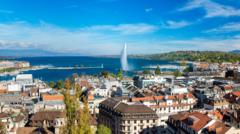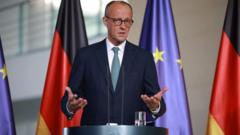Spain's remarkable recovery post-COVID, driven by tourism, investment, and progressive reforms, showcases its resilience and economic potential despite looming challenges.
**Spain's Economic Resurgence: The New European Leader**

**Spain's Economic Resurgence: The New European Leader**
Discover how Spain has transformed its economy to become Europe's economic leader in recent years.
As winter settles over Segovia, tourists flock to admire the city's iconic Roman aqueduct, captivated by its history and beauty. The bustling streets reflect a renewed vibrancy, with locals and visitors alike drawn to Spain's cultural allure and culinary delights. “After the pandemic, I feared we wouldn’t return to pre-COVID tourism,” shares Elena Mirón, a seasoned guide. “But things are looking up for 2023 and 2024, and I'm grateful that I can sustain my passion for this job.”
Spain stands out among European economies, welcoming a record 94 million visitors in 2024, second only to France. The surge in tourism has been fundamental to Spain's robust economic growth, boasting a 3.2% GDP increase last year, in sharp contrast to Germany’s 0.2% contraction, and modest growth in France (1.1%), Italy (0.5%), and the UK (0.9%). Reflecting on this success, the Economist magazine has honored Spain as the top-performing economy globally.
“The Spanish model thrives due to its balance, ensuring sustainable growth,” remarks Carlos Cuerpo, the business minister for the Socialist-led coalition. He emphasizes that Spain's contribution to eurozone growth represents 40% of the total last year. While tourism plays a significant role, sectors such as finance, technology, and investment bolster this economic revival — a marked improvement since the depths of the pandemic, during which GDP plummeted by 11% in one year.
Post-pandemic recovery funds from the EU's Next Generation program are pivotal in Spain's modernization efforts. Set to receive €163bn by 2026, Spain aims to upgrade its national rail system, enhance low-emission zones, support electric vehicle initiatives, and fund small businesses. “Public spending has driven about half our growth since COVID,” states María Jesús Valdemoros, an economics lecturer at IESE Business School.
Unlike other major economies struggling with industry-related challenges, Spain's diverse economic structure positions it for resilience against shocks, including inflation triggered by global disruptions like the Russian invasion of Ukraine. While inflation spiked at 11% in July 2022 due to energy price surges, it has since decreased to 2.8% by the end of 2024. Emergency measures, including subsidies to lower fuel costs and enhanced public transport incentives, have mitigated this crisis.
The country is also witnessing considerable growth in its green energy sector, boasting the EU's second-largest renewable infrastructure. This development aligns with Spain's status as Europe's second-largest automotive producer. Although the electric vehicle sector is still developing, industry leaders see vast potential in Spain's workforce and energy policies.
Despite declining to 10.6%, Spain's unemployment rate remains the highest in the EU, nearly double the bloc's average. However, with 22 million people now employed — a record high — reforms promoting job stability and limiting temporary contracts have bolstered the labor market. Meanwhile, immigration continues to fuel debates, with Prime Minister Pedro Sánchez advocating for its necessity to support an aging population.
Looking ahead, Spain is projected to sustain its growth, outpacing its European counterparts. Nonetheless, challenges persist, notably the tourism dependency and rising public debt, which threatens financial stability. The housing crisis further complicates matters, as affordability issues leave many Spaniards in a bind. As the political landscape remains diverse and divided, navigating these challenges will be critical for Spain to maintain its momentum as the engine of European growth amidst uncertainties.
Spain stands out among European economies, welcoming a record 94 million visitors in 2024, second only to France. The surge in tourism has been fundamental to Spain's robust economic growth, boasting a 3.2% GDP increase last year, in sharp contrast to Germany’s 0.2% contraction, and modest growth in France (1.1%), Italy (0.5%), and the UK (0.9%). Reflecting on this success, the Economist magazine has honored Spain as the top-performing economy globally.
“The Spanish model thrives due to its balance, ensuring sustainable growth,” remarks Carlos Cuerpo, the business minister for the Socialist-led coalition. He emphasizes that Spain's contribution to eurozone growth represents 40% of the total last year. While tourism plays a significant role, sectors such as finance, technology, and investment bolster this economic revival — a marked improvement since the depths of the pandemic, during which GDP plummeted by 11% in one year.
Post-pandemic recovery funds from the EU's Next Generation program are pivotal in Spain's modernization efforts. Set to receive €163bn by 2026, Spain aims to upgrade its national rail system, enhance low-emission zones, support electric vehicle initiatives, and fund small businesses. “Public spending has driven about half our growth since COVID,” states María Jesús Valdemoros, an economics lecturer at IESE Business School.
Unlike other major economies struggling with industry-related challenges, Spain's diverse economic structure positions it for resilience against shocks, including inflation triggered by global disruptions like the Russian invasion of Ukraine. While inflation spiked at 11% in July 2022 due to energy price surges, it has since decreased to 2.8% by the end of 2024. Emergency measures, including subsidies to lower fuel costs and enhanced public transport incentives, have mitigated this crisis.
The country is also witnessing considerable growth in its green energy sector, boasting the EU's second-largest renewable infrastructure. This development aligns with Spain's status as Europe's second-largest automotive producer. Although the electric vehicle sector is still developing, industry leaders see vast potential in Spain's workforce and energy policies.
Despite declining to 10.6%, Spain's unemployment rate remains the highest in the EU, nearly double the bloc's average. However, with 22 million people now employed — a record high — reforms promoting job stability and limiting temporary contracts have bolstered the labor market. Meanwhile, immigration continues to fuel debates, with Prime Minister Pedro Sánchez advocating for its necessity to support an aging population.
Looking ahead, Spain is projected to sustain its growth, outpacing its European counterparts. Nonetheless, challenges persist, notably the tourism dependency and rising public debt, which threatens financial stability. The housing crisis further complicates matters, as affordability issues leave many Spaniards in a bind. As the political landscape remains diverse and divided, navigating these challenges will be critical for Spain to maintain its momentum as the engine of European growth amidst uncertainties.




















